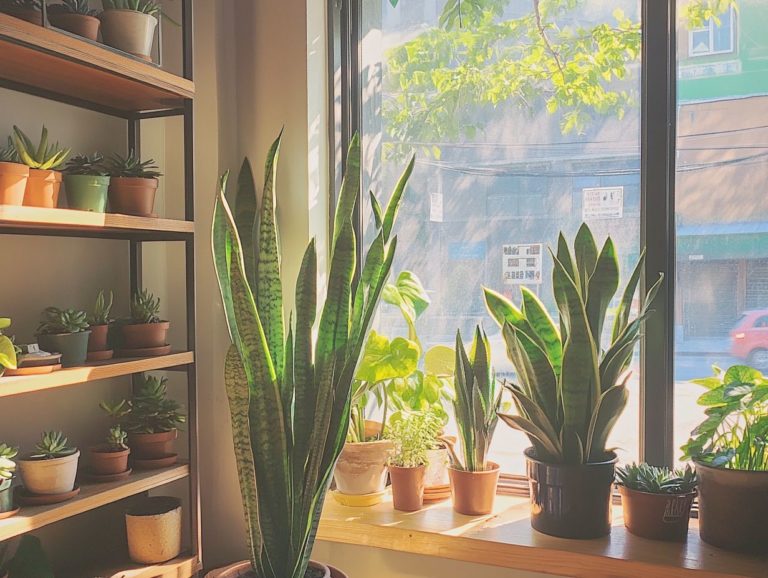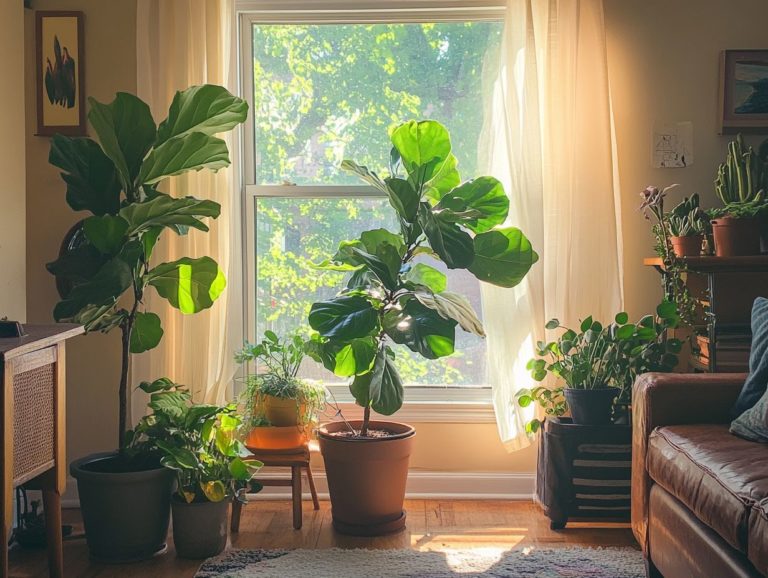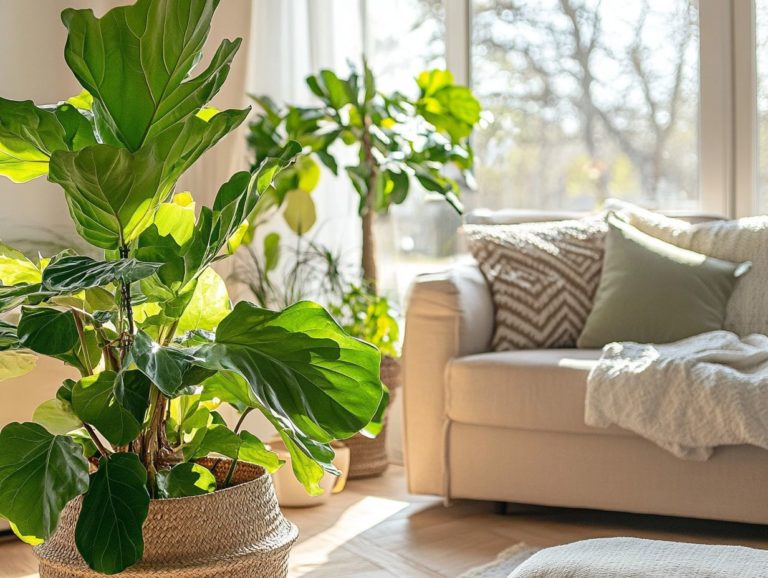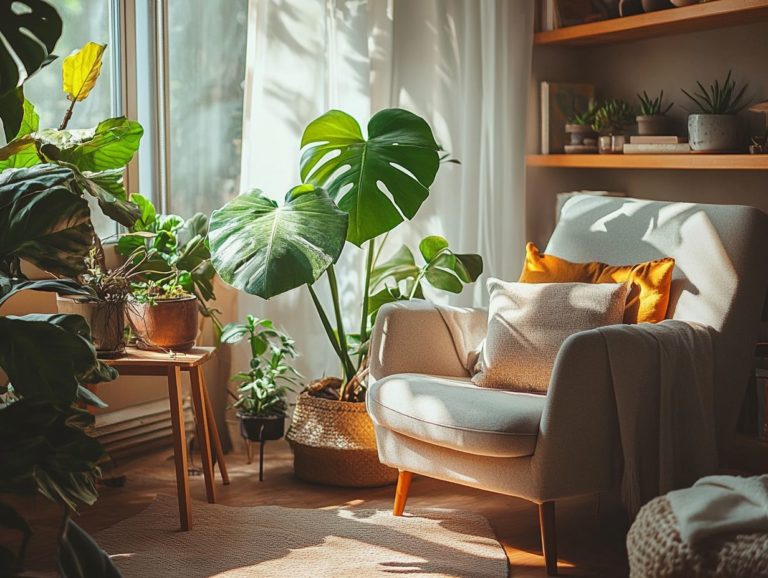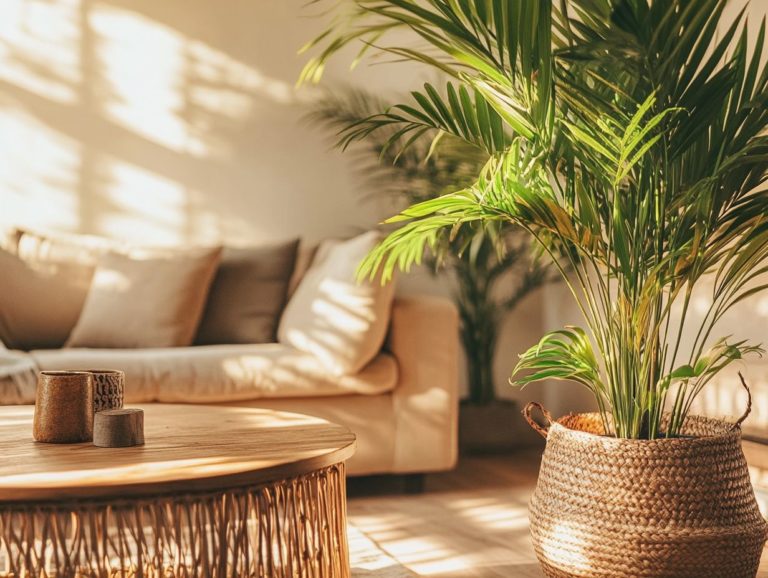How to Care for Indoor Plants in Decor
Indoor plants are more than mere decorations; they have the power to elevate your space, enrich your decor, and boost your overall well-being.
When selecting the right plants, consider various factors, including how much light is available and your personal style preferences. This article delves into essential topics such as fundamental care tips, styling plants for visual appeal, and solutions to common plant-related challenges.
Get ready to explore amazing ideas for bringing these vibrant plants into your home. Whether you re just starting out or you re a seasoned plant enthusiast, there s valuable insight here for everyone.
Contents
- Key Takeaways:
- Choosing the Right Indoor Plants for Decor
- Essential Care Tips for Thriving Indoor Plants
- Decorating with Indoor Plants
- Common Issues and How to Solve Them
- Maintaining Healthy Indoor Plants
- Incorporating Indoor Plants into Your Home Decor
- Frequently Asked Questions
- What are the best types of indoor plants to use as decor?
- How often should I water my indoor plants used as decor?
- Can I use any type of pot or container for my indoor plants?
- What is the best location for my indoor plants in decor?
- How do I prevent pests from infesting my indoor plants used as decor?
- How can I ensure my indoor plants as decorative elements last a long time? Ensure your indoor plants thrive by providing proper care. Focus on watering, fertilizing, and pruning as needed.
Key Takeaways:
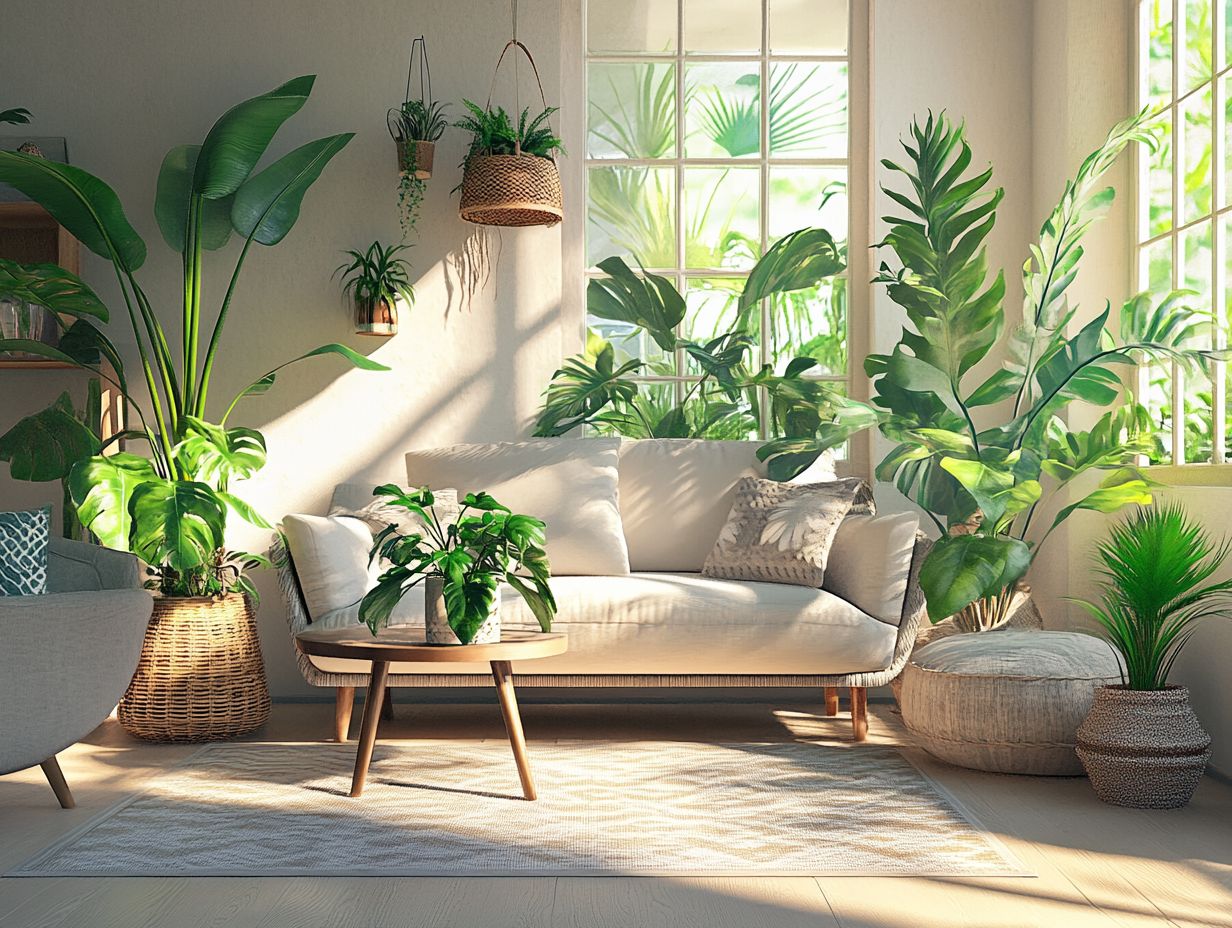
- Quickly choose the right indoor plants that will thrive in your environment and fit your decor style.
- Provide proper care by understanding watering, sunlight, soil, and fertilizer needs.
- Incorporate indoor plants into your home decor by considering placement and styling, including the use of decorative containers.
Choosing the Right Indoor Plants for Decor
Selecting the perfect indoor plants for your decor can truly transform your home s ambiance, infusing it with organic vibes that elevate your living space while seamlessly complementing your design aesthetic.
Whether you opt for a striking tall plant like the majestic snake plant or a lush leafy companion such as pothos or a fiddle-leaf fig tree, the choices are abundant. Before you make your selection, take a moment to consider essential factors such as how much light is available, the plant’s size, and how it harmonizes with your overall decor scheme.
This thoughtful approach ensures a beautiful blend of aesthetics and functionality in your home.
Factors to Consider
When selecting indoor plants, you must consider several factors to ensure they thrive and elevate your home decor.
How much light is available is paramount; it dictates which plants will flourish in specific areas of your home. Some species bask in bright, direct sunlight, while others thrive in low-light conditions. Knowing your space s lighting is essential to making the right choices.
The amount of moisture in the air also plays a significant role, particularly in drier environments where some plants may struggle to survive. Keeping an eye on this can be the difference between a flourishing plant and a wilted one.
The size and growth patterns of various plants should harmonize with the dimensions of your space, enhancing rather than overwhelming your decor.
By thoughtfully considering these factors, you can curate a collection of houseplants that align with your aesthetic preferences and meet their care requirements. Additionally, learning how to maintain soil moisture for indoor plants will help create a harmonious and inviting atmosphere in your home.
Essential Care Tips for Thriving Indoor Plants
Grasping the fundamental principles of indoor plant care is crucial for their health and longevity. Not only does this knowledge influence their growth, but it also enhances their role in elevating your home decor.
Watering and Sunlight Needs
Watering and sunlight needs can vary significantly among indoor plants, so it s essential for you to understand the specific requirements of each to promote optimal health.
Take succulents and cacti, for example; they thrive on infrequent watering, needing your attention only every two to three weeks thanks to their desert origins. In contrast, plants like ferns crave moisture more regularly perhaps two to three times a week. Overwatering can lead to root rot, which occurs when the roots sit in too much water and start to decay, leading to other issues that can compromise a plant’s well-being.
Sunlight exposure plays a crucial role as well; snake plants flourish in low light, while herbs like basil require bright, direct light to truly thrive. By understanding these individual needs, you can ensure that each plant remains vibrant and healthy.
Start your indoor garden journey today and transform your living space!
Soil and Fertilizer Requirements

The right soil and fertilizer are essential for nurturing your indoor plants. They play a crucial role in growth and overall well-being.
Different plants have specific needs, so understanding the types of potting soil is vital. For instance, cacti and succulents thrive in well-draining mixes that prevent water retention. In contrast, tropical plants prefer heavier blends rich in natural materials that help soil hold moisture. Quality soil not only supplies necessary nutrients but also promotes healthy root development.
When it comes to fertilization, establish a routine with balanced fertilizers like a 10-10-10 formula or liquid options such as fish emulsion. These can greatly enhance the vitality of your plants.
Apply these nutrients correctly to achieve vibrant foliage in popular houseplants like pothos and spider plants.
Decorating with Indoor Plants
Decorating with indoor plants allows you to infuse creativity into your space. This transforms your environment into a serene oasis.
Thoughtfully arranging plant displays elevates the aesthetics of your home and fosters a sense of tranquility in your daily life.
Placement and Styling Tips
Placement and styling tips for your indoor plants can significantly influence their health and overall beauty.
Select the right spot for each plant type. Tall house plants thrive in corners or near windows, soaking up ample light without overwhelming the space. Vibrant, smaller leafy varieties make stunning accents on shelves or side tables.
Integrate plants with stylish elements like colorful pots, chic stands, or complementary decor pieces to enhance their visual impact.
In living areas, arrange plants at varying heights for added dimension. In bedrooms, place smaller plants on bedside tables to create a soothing ambiance.
Each room offers a unique opportunity to blend greenery with your furnishings, transforming your space into a harmonious retreat.
Common Issues and How to Solve Them
Indoor plants face challenges like pest infestations and lackluster growth. These require your proactive attention.
Use effective troubleshooting techniques to protect their health and ensure they thrive beautifully at home.
Pest Control and Troubleshooting
Effective pest control is crucial for maintaining the health of your indoor plants.
Common pests like aphids, spider mites, and mealybugs can disrupt your indoor garden’s harmony. To tackle these pests, consider introducing beneficial insects, using insecticidal soap, or mixing a mild solution of dish soap and water for a natural remedy.
Regular plant inspections help catch problems early. Providing adequate light, humidity, and proper watering practices can prevent health issues.
By incorporating these strategies, you can cultivate thriving plants that enhance your living space.
Maintaining Healthy Indoor Plants

To maintain healthy indoor plants, embrace regular maintenance practices that support their growth and longevity.
By nurturing these green companions, you create a vibrant atmosphere and infuse your space with a touch of nature’s elegance.
Start caring for your plants today! What s your favorite indoor plant?
Regular Maintenance and Repotting
Regular maintenance and repotting are essential for the health and growth of your indoor plants. This ensures they have the space and nutrients they need to thrive.
Understanding the rhythm of your plant’s growth cycle can significantly boost its vitality. Over time, your indoor plants may outgrow their pots, leading to issues like roots getting too crowded or nutrient depletion. To enhance their health, check out this guide on how to position plants in your home.
If you notice signs like yellowing leaves, stunted growth, or roots poking out from the drainage holes, it’s a clear signal that it’s time for a repotting. When you take on this task, opt for a slightly larger container filled with fresh potting mix to provide essential minerals and facilitate proper drainage. Additionally, consider using hardy indoor plants that are easier to care for and can thrive in various environments.
This practice promotes healthy growth and revitalizes the soil. This allows your plants to absorb nutrients more efficiently and flourish beautifully in their indoor environment.
Incorporating Indoor Plants into Your Home Decor
Transforming your home with indoor plants can be an exciting adventure! It allows you to create vibrant, living environments that radiate organic charm and warmth.
Creative and Unique Ideas
Creative and unique ideas for styling your indoor plants can truly elevate your home decor. They allow you to showcase your personal style while welcoming the beauty of nature into your space.
By weaving greenery into various aspects of your home, you can craft environments that feel vibrant and inviting. From striking hanging planters that draw the eye skyward to stunning vertical gardens that transform bare walls into lush canvases, the possibilities are limitless. To ensure your indoor plants thrive, it’s crucial to understand how to maintain soil health for indoor plants.
Picture arranging a collection of succulents on a chic shelf alongside your favorite curated books or artwork. This creates a seamless fusion of nature and design. Incorporating plants into your furniture, think wooden plant stands or integrating them into side tables, can foster a delightful balance between plant care and aesthetic charm. To ensure your plants thrive, consider learning how to care for plants in different light. This ultimately enhances the overall atmosphere of any room.
Frequently Asked Questions
What are the best types of indoor plants to use as decor?
Among the best types are snake plants, pothos, fiddle-leaf fig trees, and monstera deliciosa.
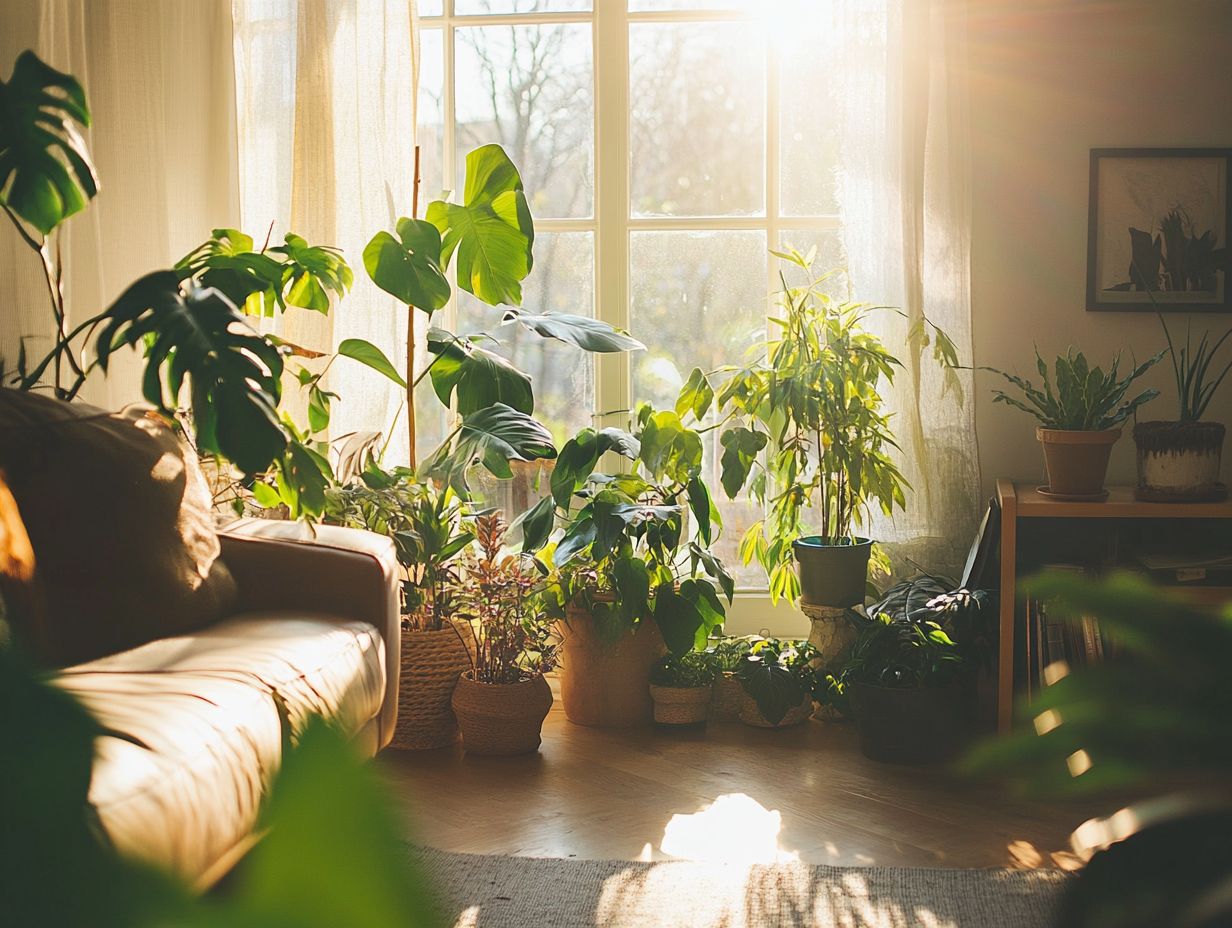
Some of the best indoor plants for decor include succulents, air plants, peace lilies, and spider plants. These plants are not only aesthetically pleasing, but they also require minimal care and can thrive in indoor environments.
How often should I water my indoor plants used as decor?
To maintain plant health, most indoor plants should generally be watered once a week. However, it’s important to check the soil moisture and adjust accordingly, especially when using potting soil.
Can I use any type of pot or container for my indoor plants?
It is recommended to use pots or containers with drainage holes for indoor plants. This allows excess water to drain out and prevents root rot. However, if you prefer a decorative pot without drainage holes, you can use a layer of rocks at the bottom to improve drainage.
What is the best location for my indoor plants in decor?
A good spot for your indoor plants is one that receives adequate sunlight, such as near a window, but not direct sunlight. Plants like amazon lilies thrive in bright, indirect light.
How do I prevent pests from infesting my indoor plants used as decor?
Regularly inspect the leaves and stems for any signs of pests or diseases. You can also use natural pest repellents, such as neem oil or vinegar, which help maintain plant growth.
To prevent pests from infesting your indoor plants, regularly inspect the leaves and stems for any signs of pests or diseases. You can also use natural pest repellents, such as neem oil or vinegar, to deter pests.
How can I ensure my indoor plants as decorative elements last a long time? Ensure your indoor plants thrive by providing proper care. Focus on watering, fertilizing, and pruning as needed.
Make sure to provide proper care and maintenance for your indoor plants. This includes watering, fertilizing, and pruning when necessary.
Pay attention to any changes in their appearance or health. Don’t wait until it’s too late! Regularly check your plants to catch any issues early.

